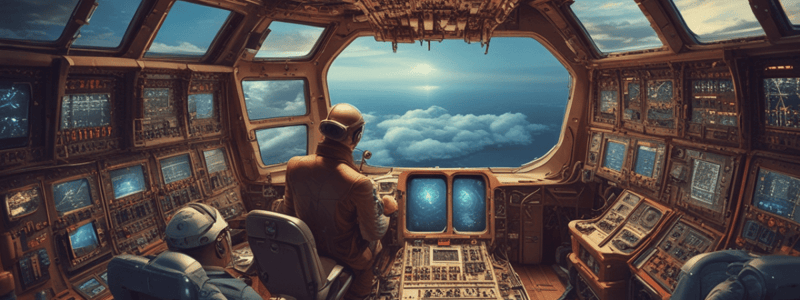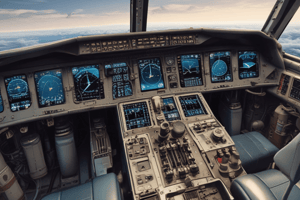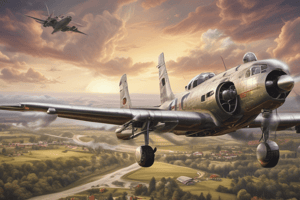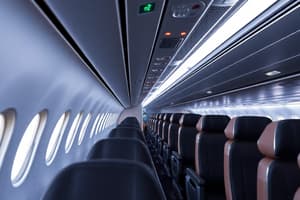Podcast
Questions and Answers
What is a potential drawback of the T-tail configuration?
What is a potential drawback of the T-tail configuration?
- Risk of deep stall (correct)
- Improved stall recovery
- Increased control effectiveness during stalls
- Reduced pilot workload
What is the primary function of flaps and leading-edge devices?
What is the primary function of flaps and leading-edge devices?
- To improve roll control during descent
- To increase wing camber and coefficient of lift (correct)
- To reduce pilot workload during takeoff and landing
- To augment lift and drag control
What is the purpose of spoilers in advanced control system design?
What is the purpose of spoilers in advanced control system design?
- To augment lift and drag control (correct)
- To increase lift during takeoff
- To assist in pitch control
- To reduce drag during cruise
How do trim systems reduce pilot workload?
How do trim systems reduce pilot workload?
What is the benefit of the T-tail configuration in terms of control effectiveness during stalls?
What is the benefit of the T-tail configuration in terms of control effectiveness during stalls?
What is the primary purpose of asymmetric spoiler deployment?
What is the primary purpose of asymmetric spoiler deployment?
What is the result of deploying flaps and leading-edge devices?
What is the result of deploying flaps and leading-edge devices?
What is a critical consideration for designers when evaluating T-tail aerodynamic characteristics?
What is a critical consideration for designers when evaluating T-tail aerodynamic characteristics?
What is the primary benefit of integrating secondary flight controls within the overall aircraft control system?
What is the primary benefit of integrating secondary flight controls within the overall aircraft control system?
What is the purpose of adjusting the neutral position of control surfaces in trim systems?
What is the purpose of adjusting the neutral position of control surfaces in trim systems?
Mechanical control systems are characterized by their indirect physical linkages between the pilot's controls and the aircraft's control surfaces.
Mechanical control systems are characterized by their indirect physical linkages between the pilot's controls and the aircraft's control surfaces.
The transition from mechanical to fly-by-wire systems reduced the aircraft's weight and improved handling and performance.
The transition from mechanical to fly-by-wire systems reduced the aircraft's weight and improved handling and performance.
Fly-by-wire systems offer reduced safety features compared to mechanical control systems.
Fly-by-wire systems offer reduced safety features compared to mechanical control systems.
The primary advantage of fly-by-wire systems is their ability to make minute adjustments slower than a human.
The primary advantage of fly-by-wire systems is their ability to make minute adjustments slower than a human.
Rigorous redundancy is required to mitigate the risk of mechanical failures in fly-by-wire systems.
Rigorous redundancy is required to mitigate the risk of mechanical failures in fly-by-wire systems.
The design of integrated control systems is a simple process that harmonizes various elements to ensure safety and efficiency during flight.
The design of integrated control systems is a simple process that harmonizes various elements to ensure safety and efficiency during flight.
Fly-by-wire systems are less complex than mechanical control systems.
Fly-by-wire systems are less complex than mechanical control systems.
The advent of fly-by-wire systems resulted in a decrease in aircraft weight.
The advent of fly-by-wire systems resulted in a decrease in aircraft weight.
Mechanical control systems rely on a series of cables, pulleys, and electronic systems to translate pilot inputs into movements of the control surfaces.
Mechanical control systems rely on a series of cables, pulleys, and electronic systems to translate pilot inputs into movements of the control surfaces.
Fly-by-wire systems are more prone to pilot-induced errors than mechanical control systems.
Fly-by-wire systems are more prone to pilot-induced errors than mechanical control systems.
What is the primary advantage of positioning the horizontal stabilizer above the vertical tail in a T-tail configuration?
What is the primary advantage of positioning the horizontal stabilizer above the vertical tail in a T-tail configuration?
What is the phenomenon that can occur when an aircraft enters a stall from which recovery is difficult or impossible in a T-tail configuration?
What is the phenomenon that can occur when an aircraft enters a stall from which recovery is difficult or impossible in a T-tail configuration?
What is the primary effect of deploying flaps and leading-edge devices during takeoff and landing phases?
What is the primary effect of deploying flaps and leading-edge devices during takeoff and landing phases?
What is the primary purpose of spoilers in terms of lift and drag control?
What is the primary purpose of spoilers in terms of lift and drag control?
How do spoilers assist in roll control during descent and landing?
How do spoilers assist in roll control during descent and landing?
What is the primary function of trim systems in terms of pilot workload?
What is the primary function of trim systems in terms of pilot workload?
What is the primary consideration for designers when evaluating the aerodynamic characteristics of T-tail configurations?
What is the primary consideration for designers when evaluating the aerodynamic characteristics of T-tail configurations?
What is the primary benefit of integrating secondary flight controls within the overall aircraft control system?
What is the primary benefit of integrating secondary flight controls within the overall aircraft control system?
How do trim systems maintain steady flight without continuous manual input?
How do trim systems maintain steady flight without continuous manual input?
What is the critical consideration for designers when evaluating the integration of secondary flight controls within the overall aircraft control system?
What is the critical consideration for designers when evaluating the integration of secondary flight controls within the overall aircraft control system?
Study Notes
Evolution of Control Systems
- Fly-by-wire systems replace manual controls with electronic interfaces, allowing for lighter, more precise, and reliable maneuvering
- Advancements in fly-by-wire technology have improved aircraft performance and safety
- Electronic signals translate pilot intent into control surface movements with precision
Leading Edge Devices
- Crucial components on the forefront of an aircraft's wings that manage airflow and improve lift during critical phases
- Future advancements will enhance device functionality, ensuring optimal performance across a range of airspeeds and angles of attack
Autopilot Systems
- Autopilot systems integrate with modern control technologies to provide a smoother and safer flight
- Capabilities have expanded to include maintaining level flight, easing pilot workload during cruise phase, and integrating with other avionics
Impact on Pilot Workload and Skills
- New technologies reduce pilot workload, allowing for greater focus on monitoring systems and strategic decision-making
- Balance between automation and manual control skills is necessary in the modern cockpit
Future of Aircraft Control Systems
- Enhanced safety, improved efficiency, and a step closer to sustainable aviation await
- Potential for fully autonomous systems in the future, but requiring new training and adaptation for pilots
Integration of Control Systems
- Modern aircraft combine mechanical and fly-by-wire systems to optimize performance
- Integration provides direct pilot feedback and automated responses
Role of Spoilers in Roll Control
- Spoilers assist in roll control by disrupting airflow, reducing lift on one wing, and aiding in turning dynamics
- Spoilers also contribute to overall aircraft performance
Autopilot System Capabilities
- Modern autopilot systems manage everything from heading to altitude and complex navigational routing
- Autopilot systems ease pilot workload, allowing focus on other vital tasks, but raise questions of reliance and skill retention
Case Examples of Integration
- Airbus A350 and Boeing 787 showcase sophisticated systems that ensure optimal performance under adverse conditions
- Integration delivers synergy, leading to smoother flights and stronger safety protocols
T-Tail Aircraft Designs
- T-tail configuration influences stall recovery, helping maintain control effectiveness during stalls
- Designers must evaluate aerodynamic characteristics to ensure safe stall behavior
Evolution of Control Systems
- Mechanical linkages replaced by electronic interfaces in fly-by-wire systems
- Fly-by-wire systems provide lighter, more precise, and more reliable maneuvering
- Digitized inputs revolutionize pilot communication with the aircraft
Fly-by-Wire Systems
- Pilot's intent translated into electronic signals, processed by aircraft's computers
- Computers move control surfaces with precision, providing inherent stability and better fuel efficiency
- Systems manage complex flight dynamics, allowing for smoother and safer flight
Leading Edge Devices
- Crucial components that manage airflow and improve lift during critical phases of flight
- Future advancements to enhance device functionality, ensuring optimal performance across a range of airspeeds and angles of attack
Autopilot Systems
- Traditionally used to maintain level flight, easing pilot workload during cruise phase
- Now capable of taking on more flying tasks, integrating seamlessly with other avionics
- Autopilot systems reduce pilot workload, allowing for greater focus on monitoring systems and strategic decision-making
Impact on Piloting Skills
- More automated cockpit influences piloting skills, requiring new training and adaptation for aviators
- Balance between automation and pilot intervention necessary for safe and efficient flight
Future Developments
- Potential for fully autonomous systems, where human intervention is the exception
- Expected benefits: enhanced safety, improved efficiency, and a step closer to sustainable aviation
Integration of Control Systems
- Modern aircraft combine mechanical and fly-by-wire systems for optimal performance
- Integrated systems provide direct pilot feedback, reliability, and precision, while reducing weight and offering sophisticated automated responses
Role of Spoilers
- Spoilers aid in roll control, reducing lift on a wing and assisting in turning dynamics
- Contribute to aircraft's overall performance and agility
Autopilot Systems in Integrated Control
- Autopilot systems manage everything from heading to altitude, and complex navigational routing
- Ease pilot workload, allowing for more focus on other vital tasks
Enhancing Safety and Efficiency
- Integration of control systems delivers a synergy that paves the way for smoother flights and stronger safety protocols
- Real-world examples, such as the Airbus A350 and Boeing 787, showcase advanced control systems in modern aircraft
Evolution of Control Systems
- Mechanical linkages replaced by sophisticated fly-by-wire systems in modern cockpits
- Fly-by-wire systems: electronic interfaces, lighter, more precise, and more reliable
- Digitized inputs revolutionize pilot-aircraft communication
Fly-By-Wire Systems
- Replace manual controls with electronic signals
- Pilot's intent translated into electronic signals, processed by aircraft's computers
- Precise control surface movement, inherent stability, better fuel efficiency, and complex flight dynamics management
Leading Edge Devices
- Manage airflow and improve lift during critical phases (takeoff and landing)
- Future advancements will enhance functionality, ensuring optimal performance across airspeeds and angles of attack
Autopilot Systems
- Integrate with modern control technologies to optimize performance
- Manage everything from heading to altitude, and complex navigational routing
- Ease pilot workload, allowing focus on other vital tasks, but raise questions of reliance and skill retention
Integration of Control Systems
- Combine mechanical and fly-by-wire systems for reliability, precision, and flexibility
- Leverage pros and cons of each system: mechanical (direct pilot feedback) and fly-by-wire (reduced weight, sophisticated automated responses)
Role of Spoilers
- Assist in roll control, especially during roll
- Contribute to turning dynamics and overall performance
- Disrupt airflow, reducing lift on one wing, aiding in roll control
Case Examples
- Airbus A350 and Boeing 787 showcase integration of modern control systems
- Ensure optimal performance even under adverse conditions, a testament to innovation in aircraft design
Future of Aircraft Control System Integration
- Promises further advancements in safety, pilot assistance, and possibly fully autonomous flights
- Fundamentals remain grounded in discussed principles, ensuring continued exploration and adaptation
Studying That Suits You
Use AI to generate personalized quizzes and flashcards to suit your learning preferences.
Related Documents
Description
Explore the future of aircraft control systems and their impact on piloting experience and flight safety. Learn about the evolution of control systems and the advancements that will shape the industry.




